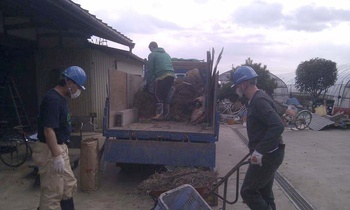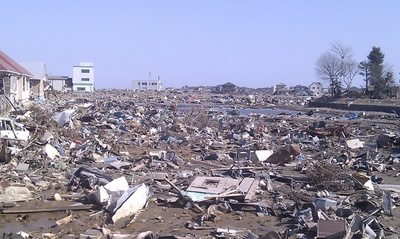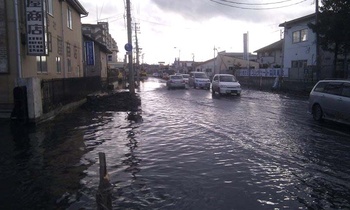I am writing this on April 24th, more than a month after the earthquake and tsunami that devastated the coastal and inland areas of Tohoku Region in eastern Japan.
Many thoughts are running through my mind at this point: the “incomplete” media coverage of this issue; the sudden jump from Level 5 to Level 7 at the Fukushima nuclear plant and my friend Shogo Horiuchi who lives 35 kilometers away from there; my friend Senji Kurosu in Sendai who continues to lead a group of volunteers; ALT Chris Nicholls and my friend Tomo and family who are heading back to Sendai at the end of April.
First thing’s first: I know that I should not expect much in the way of genuine compassion from the media. Don’t they operate under the myth of journalistic objectivity at times like this? They make much more of an effort to put a “human face” on other disasters when it serves their needs. Unfortunately, even when given an opportunity like this to get to know what the Japanese people are truly like beyond the stereotype, the media ignores the humanity of the victims and those who are helping and, instead, look at the disaster more as a cold, “unfeeling” list of numbers.
The first significant number then is March 11 and 9.0 magnitude “megathrust” earthquake. Six minutes was the duration of the quake. The number 28,000 is the estimated dead and missing. About 100,000 homes are needed for the displaced. Well over 125,000 buildings are damaged or destroyed. Level 7 makes the nuclear situation in Fukushima the second worse disaster in history, only behind Chernobyl. The government said the cost of the devastation could reach $309 billion, making it the most expensive natural disaster on record.
Is that the end of story, then? In Canada, media coverage by CBC TV has all but stopped. CTV news is doing a better job, trying to put a face to the victims, but reports now are scant. I’m still waiting for a story about the Canadian teachers who chose to stay and are doing courageous volunteer work in Tohoku?
However, by putting a human face on to the disaster aren’t we are upping the level of our global responsibility? Our shortened attention span and modern lifestyle makes it difficult for us to connect with the tragedy in Japan, even if we are Nikkei.
Forgive the rant, but “the media” rarely ever gets Japan right and makes little effort to do so. We may get reports from “the battle front” in Libya, but no closer than Tokyo or Kyoto when reporting about the disaster that is happening on the other side of Japan. It still befuddles me as to why, when there are so many English-speaking support and government workers these days that reports from Japan to the English-speaking world are so poor. I’ve sent several contact names to many news services and none has ever followed up on my offer. My conclusion: they just don’t give a damn.
Senji has told me about volunteers, many of whom have put their professional lives on hold in order to help out in the disaster zone. The jieitai (Japanese Self-Defense Forces) has been doing relief work from the beginning of this crisis. The American armed forces have been deeply involved in “Operation Tomodachi” from the outset too. “Why Canada is not on the ground helping there too?” friends in Japan ask. Now, is this because of the Japanese government’s miscalculated “bungling” of this disaster or more of a “let-Japan-handle-this-alone” world attitude?
Although there is a semblance of normalcy returning to Sendai, this should not be taken as the general situation in the disaster zone where the huge heaps of rubble in the devastated coastal cities, towns, and villages are slow to be cleaned up. The dead still need to be identified and respectfully put to rest too.
I first met Shogo around 10 years ago when I was teaching English in Sendai. He had studied economics at Fukushima University and was working at a money collection agency. He was studying TOEIC in hopes of eventually going abroad to study. He was a regular member of our after-class group that would gather for beer at our favourite haunt, “Makan”. He likes jazz and once went all the way to New York City on a four-day vacation (sic) just to visit some famous clubs there. Before the disaster, he wrote to say that he wanted to visit Canada this summer.
When I was in Sendai two summers ago, Shogo took the Shinkansen to Sendai just so that he could drink beer with the old English school gang, then headed back on the last train. Shogo is in the midst of rebuilding his life on the family rice farm in Minami Soma City in Fukushima where he lives. Every day he goes out to what remains of his home and cleans up the best he can. His four nephews and nieces with whom he is now living are going back to school at the end of the month (the school year normally starts in April) and he remains remarkably positive about his situation while emphasizing that “local people do not trust the government.” Three bodies were pulled out of the nearby wreckage in a recent body recovery effort by the jieitai in his neighborhood.
Prime Minister Naoto Kan was accused of accepting “illegal money” from Korea (where his mistress and son live) shortly before the disaster struck.
It didn’t help his party’s image that the Tokyo Electrical Company (TEPCO) CEO, Masataka Shimizu, “disappeared” for weeks amidst rumours including suicide at the height of the nuclear crisis in Fukushima or that Kan’s hastily assembled Emergency Relief group appears incompetent. The government head of volunteer services, Kiyomi Tsujimoto (Osaka), cancelled a planned trip to the affected area because it was raining. In the ongoing national elections, the Minshuto party is taking a pummeling.
My friends Senji and English teacher Chris Nicholls from England, are spending every spare moment helping people in and around the area. Chris and his ALT friends are in schools teaching English games and songs to kids to help them regain a sense of normalcy. Some of the hardest hit areas on the Pacific coast that were hit by the up to 37.9-meter (124-feet) high tsunami that my mother still refuses to believe is true. “How could it possibly have been 10-storeys high?” she says with skepticism.
My Canadian Nisei friend Tak Matsuba in Osaka wrote to tell me that “Soil collapse was and is very serious. My daughter in Tokyo was out shopping when the quake struck and she could not get back into her apartment building for a while due to soil collapse.
“There are areas in Tohoku where the land has sunk a meter or more. Every time there is a high tide, the first floors of the homes in such areas are inundated. It is very sad to see the news on the TV. Those people have suffered enough without this continuing problem,” he says.
I recently talked to Senji about the situation by phone. He is extremely disappointed by the response of the Japanese government. He does point out, however, that he has met remarkable individuals, including business people, celebrities, religious organizations, academics, and concerned private citizens who have made remarkable acts to show they care. Some individuals even filled trucks full of blankets, food, and other goods at their own expense and drove them to the affected areas themselves.
Senji recently drove to Fukushima and reports that the people there are desperate for help.
Still, there are also remarkable bright spots too. The pro golfer, Ryo Ishikawa, 19, will donate his 2011 earnings to the relief cause as well as 100,000 yen for every birdie he makes; pro baseball players like Ichiro (Seattle) and “Dice-K” (Boston) have both donated more than $1 million each; in Canada, Linda Ohama and her team in Vancouver organized the remarkably successful “Gambare Japan!” fund raiser; National Association of Japanese Canadians president Ken Noma’s team made a similar effort in Toronto.
There is also a long list of celebrities in Japan who have visited the affected area to offer their moral support: actor/singer Sugi Ryotaro and enka singer wife Natsuko Godai, actresses Aya Uesugi and Norika Fujiwara (for the Red Cross), SMAP’s Nakai-kun, comedians “Koroke” and Koujii Tomita, various members of Guntan Ishihara Actors Company and many others have made sincere and deeply felt efforts to show their spiritual comradery with the survivors who, indeed, are not alone in the long, hard years of rebuilding that lay ahead of them.
Now that, dear friends, is the essence of “kizuna”.
© 2011 Norm Ibuki









